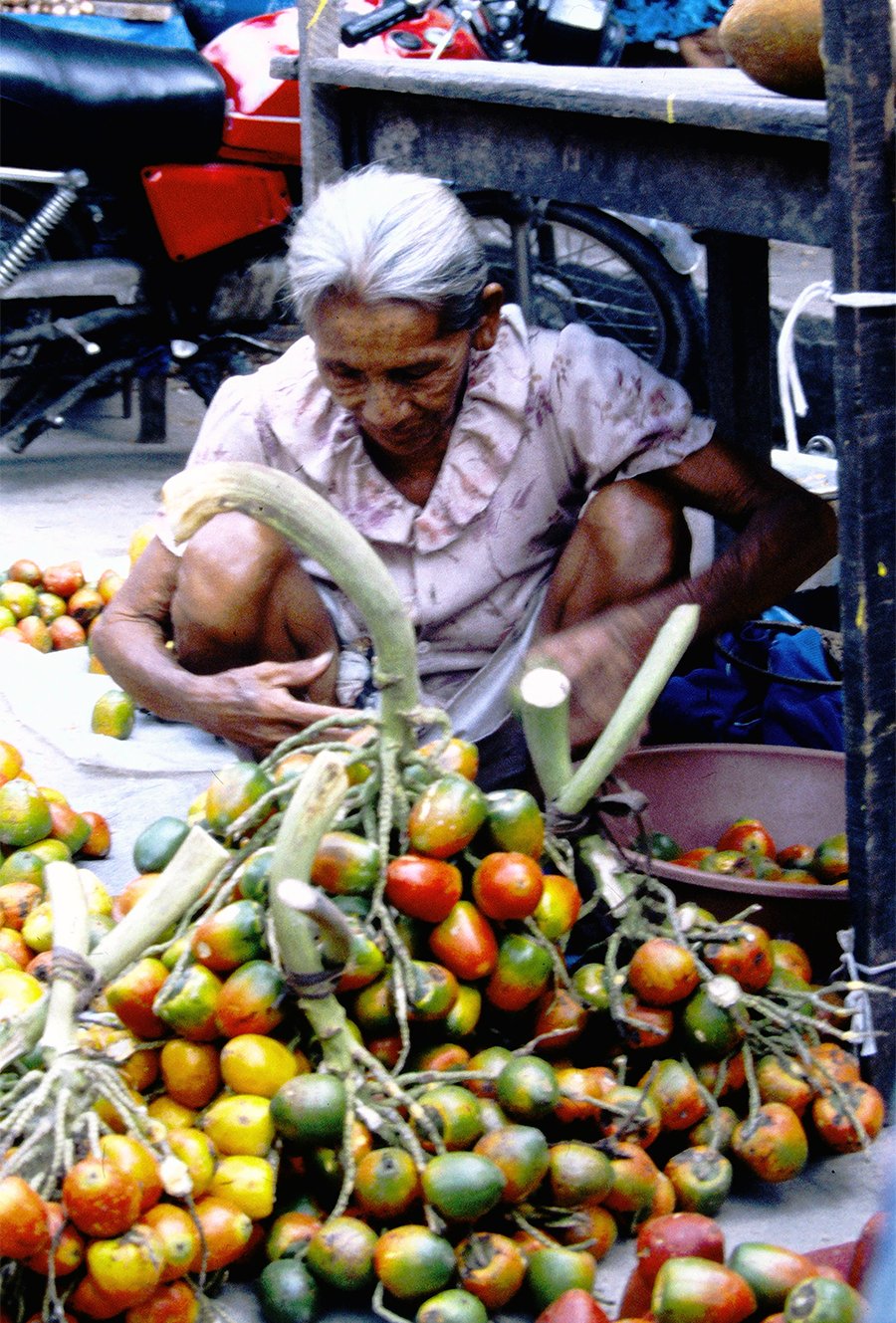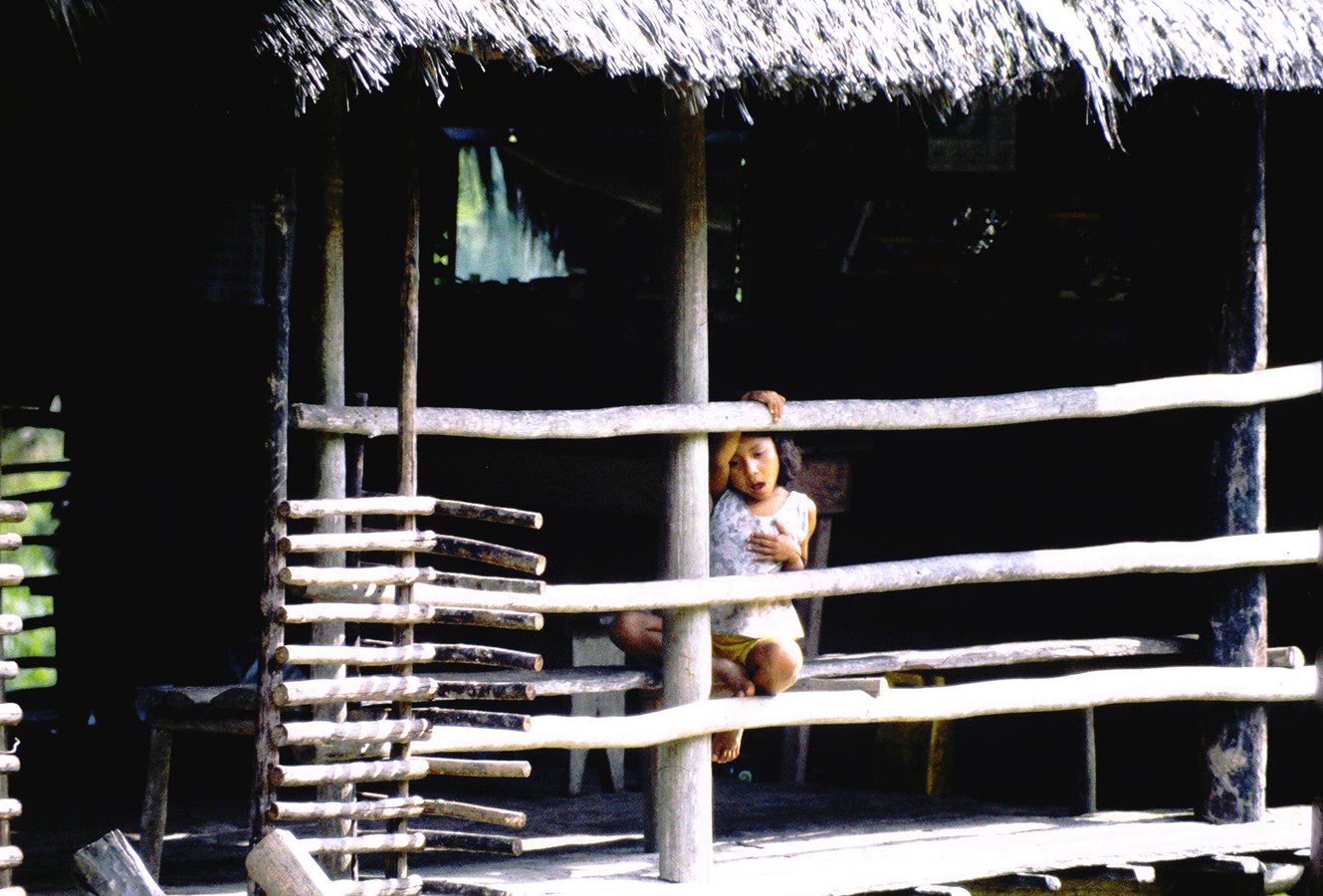ADVENTURES IN THE AMAZON
University Wire
04-15-1998
(The Technician) (U-WIRE) RALEIGH, N.C. — Morning, in the crowded streets of Iquitos, finds young entrepreneurs squealing “one dollar, one dollar”; little boys rely on their innocent faces to obtain money from softhearted tourists. Their eyes fall on me, but I assure them in my broken Spanish that I have no money and that one meal a day is an accomplishment. Their faces become solemn, but curiosity prevails and they continue to follow the procession of N.C. State students through the bustling market.
Stands filled with mango, coconut and bananas line the streets. Shirtless teenaged boys carry baskets of featherless chickens on their heads. People haggle over piranha prices as well as various other fresh catches. Little bottles of herbs containing cures for myriad ailments as well as hallucinogenic drugs line the tables. The market ends as it approaches the edge of the mighty Amazon River.
The market was only the starting point of a seven-day excursion in March to the Amazon rainforest undertaken by 16 students and Dr. Robert Bruck, an enviromental science professor at NCSU, who was the trip leader. This year was the third he has provided students the opportunity to spend Spring Break in South America studying various Indian cultures and the overwhelming spectrum of Amazonian plants and animals.
Our first contact with the rainforest was soon after leaving Iquitos, as we motored down the river toward the Explorama Lodge. The concrete buildings and logging factories in Iquitos soon gave way to dense jungle. Every mile or so, an area of forest had been cleared which gave us our first glimpse of the native lifestyle. Palm-thatched roofs sat on stilts, and naked children jumped from the water’s edge, enjoying an afternoon bath. Farmers and fishermen passed us, paddling canoes filled with bananas or fish, and we exchanged big smiles and friendly waves.
Fifty miles down the Amazon we turned into a small tributary where the river’s width is a mere 10 to 20 feet. Our itinerary fit three weeks of activity into one, so we jumped from the boat and hit the ground running.
Our first hike was on a trail that followed the dwindling tributary. It was extremely humid and sweat poured from my face as I trudged over the trail. Ari, our guide, pointed out that we were walking through lowland jungle, which was subject to flooding, thus explaining the muddiness of the trail. We stopped periodically to learn about local flora and observe wildlife, as well as to provide a non-moving target for the mosquitos. I began to seriously question the effectiveness of REI’s bug repellent as various parts of my body swelled from sting on top of sting.
But we survived, and the rest of the afternoon was spent hunting insects, chasing butterflies, avoiding the playful bites of the camp’s toucan and making conversation with the parrots who inhabit the grounds.
After dinner we took an evening boat ride, hunting the black caiman. Drifting quietly down river, we used flashlights to seek out sleeping owl butterflies, croaking tree frogs and snakes resting in the overhanging branches.
Spotting a whooping snake, our guide asked if anyone would like to hold it. Tamara Trentlage, the snake handler of our group, reached for the sleeping serpent. His peace disrupted, the angry snake whipped around, sinking his fangs into her forearm. She remained calm and removed his jaws from her arm. I appreciated her self-control, and also that the snake was not let loose in our boat.
After taking care of the minor wound and stealing close-up looks at our catch, we pushed on. Our flashlights soon found the red reflection of the caiman’s eye. He took refuge beneath the water, and Ari gave the lights-out signal as we waited for him to resurface. Our guides used their jungle-trained senses to find the caiman, and we caught one last glimpse before he slipped into the night.
The following day we headed further down river to the Explornapo Lodge. Our goal today was to find the three-toed sloth. We searched the trees lining the Amazon and its tributaries. Soon enough our eagle-eyed guides spotted a sloth, which was easily 50 yards up a tree and another 50 from the part of the river we were on. Furthermore, the only part of the sloth visible from our vantage point was his arm, splendidly camouflaged on the gray tree bark.
The guides’ abilities to spot animals were incredible and they spent much time trying to explain what branch the sloth was on before everyone could see him. When we had him in sight, Ari began to reveal the secrets of the sloth’s life and we watched for 20 minutes, during which time the sloth did not make a move. However, many people I encountered in the dorms last year were more stagnant than this sloth.
We then left the brown waters of the Amazon and ventured into the piranha-infested black creeks. The two mix like oil and water; streaks of black and brown run together to form what looks like a child’s finger painting. The creek was only six feet across in places and Ari used his machete to keep branches from hitting our heads. We saw the shadows of spider monkeys as they hopped around in treetops and watched hawks and birds with exotic coloration soar above our heads.
The birds were not alone in the sky, because storm clouds were building. We were soon soaked to the bone. Afternoon showers occur regularly in the rainforest and the cool water was refreshing after the day’s heat and soothing to our sunburned bodies. As the storm ended, the wall of vegetation pulsating along the edge of the river took on the appearance of a massive, saturated green sponge.
Back at the lodge, a few students decided to go fishing, so I joined them to see what strange creatures would emerge from the murky depths. Russell Herman, avid fisherman and N.C. State senior, was reeling in a catfish whose whiskers were twice as long as its body when I spotted a spiral of yellow and black gliding across the water toward our living quarters. “Snake!” Everyone turned; Ari and I tore off in its direction for a closer look. We found an eight-foot bushmaster slithering onto shore, but he soon took refuge in a small hole in the mud wall. We spent some time trying to flush him out, but he was content in his hole.
That afternoon we hiked to the Amazon Center for Environmental Education and Research. It was the focal point of our trip because of the research center’s canopy walkway. It is 120 feet above ground in places and is about a quarter-mile long. In the early morning, we headed to the walkway to watch the sunrise. Unfortunately, cloud cover made the sunrise less than impressive, but with several more trips planned, we were not concerned.
The afternoon was spent exploring the denser region of jungle we were now in. Ari caught a tree frog and, later, one of the poison dart variety. He handed the inch-long black frog with two body-length yellow stripes to me so that those in the back could see.
After dinner we returned to the walkway in anticipation of sunset. Our view was once again obstructed, but the backlit clouds produced a spectacle of erupting oranges and deep purples, which soon disappeared with the dying day.
That night my dream world was bombarded by sunrises exploding into the sky over and over. Waves of light poured over the treetops, illuminating the lush forest. So I had high hopes as we made our way to the walkway at five in the morning. But, to my disappointment, we were met by an impending storm. Before the rains, we were visited by bright yellow Orioles, a Saki monkey, pygmy squirrels and a swarm of toucans.
That was our last visit to the walkway, and we made our way back to the Explornapo, where a bit of freedom allowed me to head off down the trail by myself, hunting the red poison dart frog. Walking alone also gave me a true appreciation of the rhythms of the rainforest with which the Indians have learned to live in harmony.
That afternoon we went on a boat ride to find pink river dolphins and took time to swim in the Amazon. We spent our last day hiking and visiting a Yagua Indian village. Children with potbellies rushed to a hut where we were asking questions of the tribe’s chief. He wore traditional warrior’s garb—a grass skirt and headdress decorated with bright green leaves. The chief gave a short demonstration with his blowgun, but most natives have given up this traditional hunting weapon for the shotgun.
The tribe was eager for other American possessions as well. We bartered T-shirts for various artwork, pottery and jewelry. I traded for a six-foot blowgun, which now hangs proudly on my wall. Tied to the gun is a woven satchel that contains a cotton-like substance used to make the dart’s placement in the barrel airtight and the lower jaw of a piranha, which is used to sharpen the darts. A palm frond quiver holds the darts, which are responsible for the tiny holes in my roommate’s Jimi Hendrix poster.
The Amazon trip was a whirlwind experience and an excellent opportunity to expand my horizons beyond our campus. If you are interested in this trip and want more information contact me at 512-7493 or the Environmental Science Department.
by Justin Meckes
Photos were scanned from the original 35mm slides.
(c) The Technician via U-Wire









